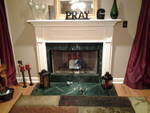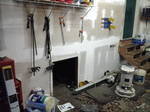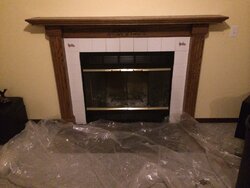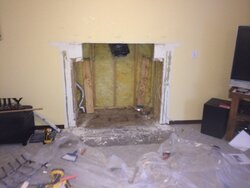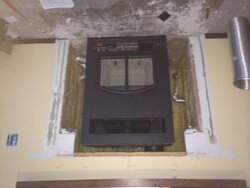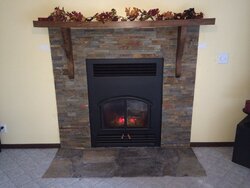I live in southern ky, almost at the tennessee border. My house was built in 1998. The main part of the house that is used the most is 1600 square feet. It is all on the bottom level except for a converted bonus room upstairs that my teenage daughter lives in. That area is not used a whole lot but is divided into two rooms and the entire area is about 12 feet wide by 50 feet long with 7 foot ceilings.
I do not have a basement. I only have a crawl space which limits the things I can do in terms of heating. I currently have forced air propane unit in the crawlspace. I have an all electric small forced air unit that is separate for the upstairs bonus room. I have propane hot water.
I would really like to reduce my utility bills. I think my biggest expense is the water heater as I have a family of four that likes to take a lot of showers.
I have attached two pictures I took quickly this morning. One is of my never used "fireplace". I have contemplated putting a wood burning stove in it's place. However, this is not masonary. There is a chimney outside. It is wood/vinyle siding with single wall pipe for the chimney. I know it would have to be replaced. However, I am worried about insurance and if it would go up. I talked to my Allstate agent several years ago who said they would not allow me to put one in. (I am not sure if he knew what he was talking about as someone I work with also has All state and they said something different.
The other thing that would be ideal with my set up is if I could place a wood burning furnace in my attached garage. Above the garage is an attic. The square opening you see in the picture is a concrete area under my house that is the entire length of the garage and is attached/part of the actual crawl space. The idea would be to run the vent from the wood burner and some how attach it to my existing forced air unit. Also, on the other side of the garage wall near that square opening is my current utility room with the water heater in it. I have seen add on heating elements for water that can be added to these furnaces. Because the water heater is higher than the furnace, I would probably not even need a water pump as I could take advantage of thermosiphon action. However, not sure if any insurance company would insure such a set up and actually, even though I heard a lot of people have wood burners in their garage, I actually looked up and it is a violation of the NFPA to have any solid fuel appliance in a garage. The theory is a garage has gasoline and things in it usually.
Other option is to build a shed and put some sort of unit in it and run the lines in the ground to the crawl space. I live on 5 acres and in the country with not a lot of codes. (I in fact have amish neighbors). However, not sure how the insurance company would feel about an indoor appliance being used outdoors.
Whatever I decide I will want to do the entire job myself. I am mechanically inclined and to be honest, there are not a lot of good contractors around here and I don't really trust anyone.
I appreciate any advice!
I do not have a basement. I only have a crawl space which limits the things I can do in terms of heating. I currently have forced air propane unit in the crawlspace. I have an all electric small forced air unit that is separate for the upstairs bonus room. I have propane hot water.
I would really like to reduce my utility bills. I think my biggest expense is the water heater as I have a family of four that likes to take a lot of showers.
I have attached two pictures I took quickly this morning. One is of my never used "fireplace". I have contemplated putting a wood burning stove in it's place. However, this is not masonary. There is a chimney outside. It is wood/vinyle siding with single wall pipe for the chimney. I know it would have to be replaced. However, I am worried about insurance and if it would go up. I talked to my Allstate agent several years ago who said they would not allow me to put one in. (I am not sure if he knew what he was talking about as someone I work with also has All state and they said something different.
The other thing that would be ideal with my set up is if I could place a wood burning furnace in my attached garage. Above the garage is an attic. The square opening you see in the picture is a concrete area under my house that is the entire length of the garage and is attached/part of the actual crawl space. The idea would be to run the vent from the wood burner and some how attach it to my existing forced air unit. Also, on the other side of the garage wall near that square opening is my current utility room with the water heater in it. I have seen add on heating elements for water that can be added to these furnaces. Because the water heater is higher than the furnace, I would probably not even need a water pump as I could take advantage of thermosiphon action. However, not sure if any insurance company would insure such a set up and actually, even though I heard a lot of people have wood burners in their garage, I actually looked up and it is a violation of the NFPA to have any solid fuel appliance in a garage. The theory is a garage has gasoline and things in it usually.
Other option is to build a shed and put some sort of unit in it and run the lines in the ground to the crawl space. I live on 5 acres and in the country with not a lot of codes. (I in fact have amish neighbors). However, not sure how the insurance company would feel about an indoor appliance being used outdoors.
Whatever I decide I will want to do the entire job myself. I am mechanically inclined and to be honest, there are not a lot of good contractors around here and I don't really trust anyone.
I appreciate any advice!


